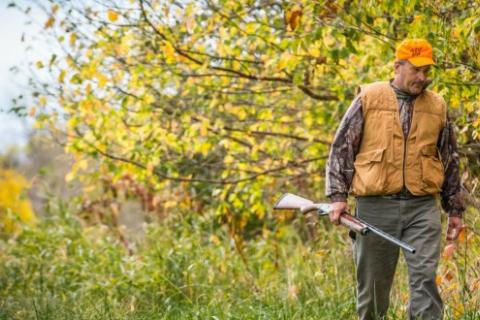
As the blur of brown fur exploded out of the brush pile, the shotgun seemed to leap to my shoulder on its own. A quick squeeze of the trigger and my first cottontail of the day was in the bag.
 You don’t need a pack of award-winning hounds to enjoy rabbit hunting success. I jumped that cottontail by simply kicking it up. You do, however, need to understand the feeding, resting, and travel patterns this great winter quarry exhibits. You’ll also want to know the best tactics for jumping them and getting good shot opportunities.
You don’t need a pack of award-winning hounds to enjoy rabbit hunting success. I jumped that cottontail by simply kicking it up. You do, however, need to understand the feeding, resting, and travel patterns this great winter quarry exhibits. You’ll also want to know the best tactics for jumping them and getting good shot opportunities.
Here are 12 insights that will up your odds for rabbit hunting success this winter:
1. Think Small
Concentrate on small farms and overlooked public hunting parcels. These places tend to be neglected by other hunters and usually have more cover than larger farms that use modern edge-to-edge agricultural practices. Look for places with brushy ditches, overgrown fence rows, and fallow fields.
2. Hunt Abandoned Property
Old dilapidated barns, farm machinery overgrown with weeds, broken-down sheds—all tend to attract rabbits. Poke around them and you may bag a cottontail or two that comes scampering out.
3. Target Sunny Slopes on Cold Days
While rabbits move mostly early and late, one exception is on sunny days following a cold front. Under these conditions, they’ll often move at midday, especially on sun-drenched south and southwestern slopes.
4. Hunt Early and Late
Years ago, rabbits moved often during daylight hours. As clean farming practices, planting fescue, and removing brushy edge cover degraded their habitat, they increasingly began moving more at night and at dusk and dawn. The hunter who gets out at daybreak or hunts the two hours before sunset will jump the most game.
5. Find the Best Vegetation
Some of the most reliable plant types to focus on include patches of greenbrier, blackberry, honeysuckle, sumac, and plum. Edges of cultivated fields with corn, soybeans, clover, and rye are also worth checking out.
6. Hit the Thickest Cover
The reason rabbits have become nocturnal is because of lack of cover, so it stands to reason that the best spots to find them are areas with dense vegitation. Search out brushy hollows, overgrown hedgerows, corners of fields, and areas with tall grasses and weeds. Railroad rights of way, clear-cuts, and fallow fields are all worth trying. Many of these spots offer tender forbs, fruits, and other food sources besides the cover they provide.
7. Watch for Sign
Keep an eye peeled for rabbit droppings—round small pellets left in piles of a dozen or more. Also watch for cottontail runways—trails they clear in their home areas for quick escape routes.
8. Work into the Wind
When possible, this approach pushes your noise and scent away from the quarry and allows you to approach closer before it flushes.
9. Zig-Zag Through Cover
The best approach for bagging rabbits is to work in a zig-zag or weaving pattern through the cover, rather than walking in a straight line. This erratic movement tends to alarm the quarry and can kick them out of hiding.
10. Take a Sudden Pause
This is a trick I use on grouse, woodcock, and pheasants, too. As you move through the cover and approach a good-looking area, stop suddenly and stand still for up to half a minute or more. Often this flushes rabbits that become unnerved by the silence and think they’ve been spotted.
11. Shoot Quickly
Carry your shotgun at port arms when in good cover to be ready for snap shots. Rabbits aren’t going to lollygag around when they bust out of a briar patch. Point at the rabbit quickly, lower your cheek to the gun, track the fleeing cottontail with the barrel, and pull the trigger just as the barrel moves ahead of the quarry.
12. Use the Right Choke & Shot Size
Typically hunters use too tight of a choke for rabbits. An open barrel is best for shots of 10-25 yards. Improved cylinder works well out to about 35 yards. There’s little use for modified or full chokes, because you’ll rarely see a rabbit farther out in the thick cover they inhabit. Sizes 4, 5 and 6 shot all work well.
Cottontail hunting offers a great way to enjoy the outdoors after deer season closes. Keep these 12 suggestions in mind and chances are you’ll be well on your way towards bagging the main ingredient for a hearty rabbit stew.
- 42835 views

